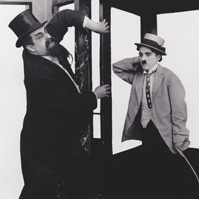 The release day for CHAPLIN’S MUTUAL COMEDIES is finally here! To mark the occasion, David Shepard, celebrated film historian, preservation expert, and owner of The Blackhawk Films Collection®, gives us an inside look at the restoration process behind this landmark collection.
The release day for CHAPLIN’S MUTUAL COMEDIES is finally here! To mark the occasion, David Shepard, celebrated film historian, preservation expert, and owner of The Blackhawk Films Collection®, gives us an inside look at the restoration process behind this landmark collection.
Can you walk us through the approach you took when restoring CHAPLIN’S MUTUAL COMEDIES?
The approach is simple to describe, but hard to do.
Every one of the films has a title card ahead of it stating where the elements came from. You can see by looking at those 12 forward titles that most of the films were sourced from several different copies, and we’re telling everyone exactly what they were.
Each of the elements was sent to the [Cineteca Bologna] laboratory in Bologna, Italy, except for a couple that were scanned in Hollywood at Technicolor. Bologna did a careful comparison, determined the best elements of each film and scanned those. Some were further restored at Bologna, but most were restored at Lobster Films.
What the restoration involved was first stabilizing the image if it was jumping up and down at all, then taking out blemishes of all kinds, usually by hand, frame by frame. You can take out punch marks, most scratches, frame lines or life lines from old splices. You can put in little pieces from one source to cover up jumps in the action that were in another source. You can steady a picture that was unsteady and adjust contrast and brightness.
If frames were missing, they were put in from other source copies and carefully balanced so you really can’t tell unless you have extraordinarily sharp eyes when we cut from one element to another.
After they were cleaned, the films were speed-corrected.
Those multiple-source, speed-corrected versions were then used to create the scores. There are 24 scores, one orchestral and one improvised piano for each film. Only the score used for ONE A.M. was in a previous release. The other 23 are all new.
What about the title cards?
The titles are all new, but replicas of the original 1916-1917 titles, unlike the reissue titles that have been used in all the other versions [of the Mutuals] since the 1920s.
Each title has 2 components: the graphics and the text. Nobody had tried to replicate the graphics before. We had one reel of an original print of ONE A.M. and one reel of an original print of EASY STREET, and we used those as a matrix for the graphics and used them to recreate the titles for the 12 films. Since ONE A.M. is from fairly early in the collection and EASY STREET from later, we made the assumption that the graphics were the same in all the Mutuals.
Those titles [in CHAPLIN’S MUTUAL COMEDIES] are faithful replicas of the original titles. Copyright documents in the Library of Congress included descriptions and title texts of all the films. Two were missing. For those, we used text from 1920s reissue prints. The titles [in the originals and the reissue prints] weren’t radically different, but occasionally had an extra word or an extra title that had been dropped over the years.
We never found a film that had an original main title, so those are all new and made to look modern.
 How did the different source materials guide your restoration decisions? Did run time influence you at all?
How did the different source materials guide your restoration decisions? Did run time influence you at all?
We did not restore for run time.
Each film was shot with two different negatives, with two different cameras: the A negative and B negative. The A negative is clearly the better one. You can tell by little things that Chaplin does that are more clever and detailed in one than the other. We tried to restore to the A negative wherever we could, but if a shot was too damaged to restore, we put in footage from the B negative. If there was more material in the B negative that was because they edited it out in the A original.
For example, in THE CURE, there’s a scene where Albert Austin who plays one of the attendants in the sanitarium walks down the hall. In the A negative, he starts to come down the hall and then it cuts away. It was edited this way. In the b neg, he comes down the hall and walks the whole way. Since we decided that we needed the B negative of that scene, we did use that take. Not because it was longer, but because we didn’t have a good condition shot of the A negative version.
You’ve worked on restorations of the Mutuals in the past. What sets this version apart?
This is by far the best, partly because we got better original material than ever before and partly because the technology has come so far in the past 10 years that even when sourced from the same material, this new version looks better.
A lot of work in the past was done at NTSC which is 525 scan lines; these were done at 2000 scan lines. And the ability to clean stuff up frame-by-frame has become exponentially more sophisticated and easier.


